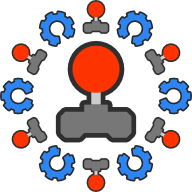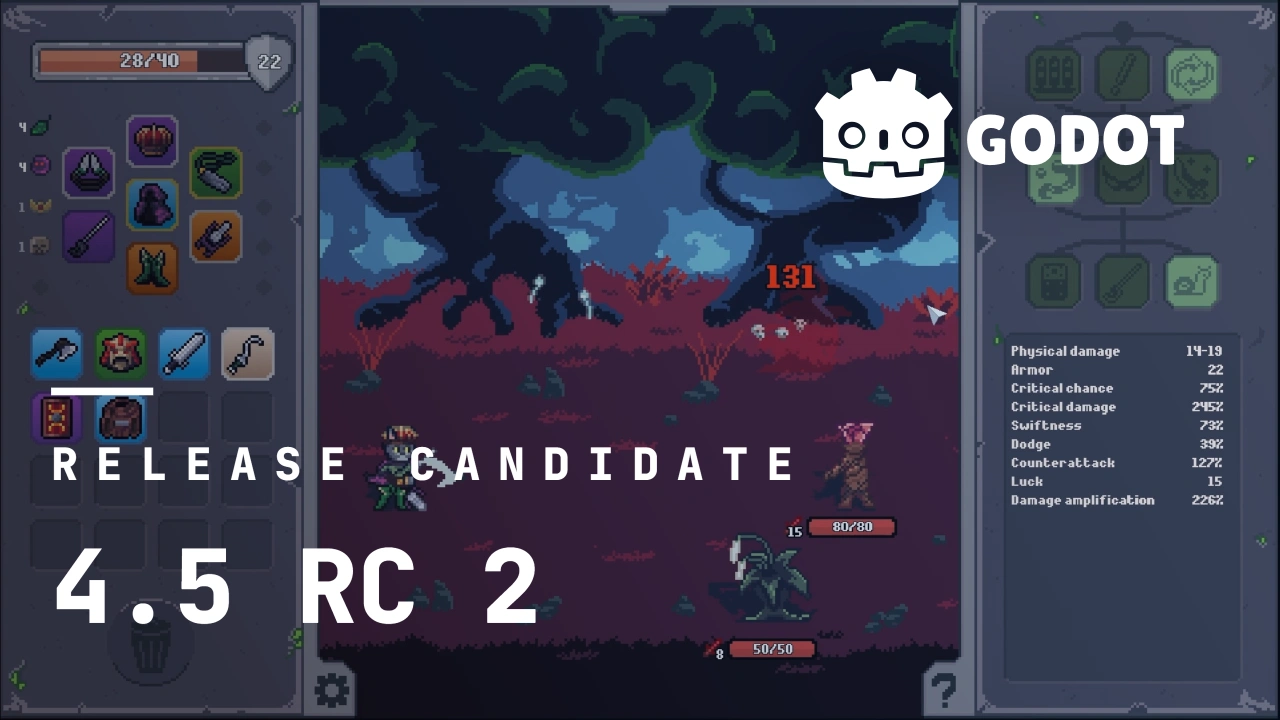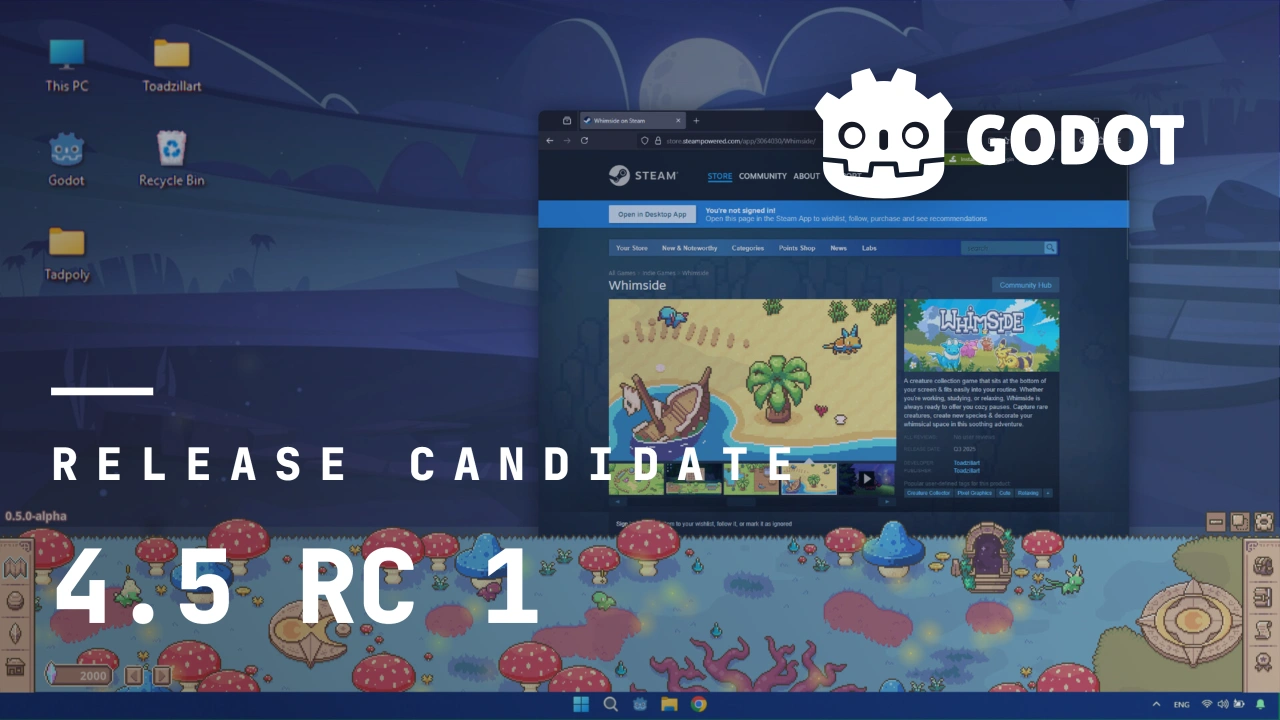Engine
There are 1,723 posts filed in Engine (this is page 5 of 173).
Ensuring quality in the Godot documentation, a continuous process
Godot 4.5, making dreams accessible
Fheroes2: version 1.1.11
Castle Game Engine: Castle Model Viewer available on iOS, Android version updated too
Release candidate: Godot 4.5 RC 2
On Friday of last week, we dropped our first Release Candidate build. As a reminder, we release RC builds once we think the engine has stabilized and is ready for release. It is your last chance to report critical regressions before we release the stable version. Now, not even a full week later, we’re ready with our second snapshot. This RC2 fixes the last of the critical regressions that we are aware of. Unless someone reports a new regression coming from the changes made in RC1 or RC2, we should be on track to release 4.5 stable soon.
At this point in the process you will see the activity on GitHub slow down as we avoid merging work for 4.5. Our focus in the coming days will be on preparing the release, and queuing up all the changes we would like to merge early in the 4.6 release cycle.
Please consider supporting the project financially, if you are able. Godot is maintained by the efforts of volunteers and a small team of paid contributors. Your donations go towards sponsoring their work and ensuring they can dedicate their undivided attention to the needs of the project.
Jump to the Downloads section, and give it a spin right now, or continue reading to learn more about improvements in this release. You can also try the Web editor, the XR editor, or the Android editor for this release. If you are interested in the latter, please request to join our testing group to get access to pre-release builds.
The cover illustration is from Overlooting, a dungeon crawler where inventory management is crucial, as you must adapt your strategy to a skill tree that changes every run! You can buy the game on Steam, and follow the developers on Bluesky.
Highlights
For an overview of what’s new overall in Godot 4.5, have a look at the highlights for 4.5 beta 1, which cover a lot of the changes. This blog post only covers the changes between RC 1 and RC 2. This section covers all changes made since the RC 1 snapshot, which are largely regression fixes:
- Animation: Move Skeleton3D init process (for dirty flags) into
POST_ENTER_TREEfromENTER_TREE(GH-110145). - Buildsystem: Bump version to 4.5-rc (GH-110285).
- Buildsystem: Fix Wayland build with OpenGL disabled (GH-110294).
- C#: Fix the issue preventing installing C# binaries on Android devices with api <= 29 (GH-110260).
- C#: Require
net9.0for Android exports (GH-110263). - Core: Fix Resource duplicate calls
ImageTexture::set_imagewith an invalid image (GH-110215). - Editor: Fix “SpriteFrames” editor not fully hidding the bottom panel (GH-110280).
- GDExtension: Fix
WindowUtils::copy_and_rename_pdbregression (GH-110033). - Rendering: Metal: Ensure baked Metal binaries can be loaded on the minimum target OS (GH-110264).
Changelog
10 contributors submitted 9 fixes for this release. See our interactive changelog for the complete list of changes since the previous 4.5-rc1 snapshot. You can also review all changes included in 4.5 compared to the previous 4.4 feature release.
This release is built from commit 2dd26a027.
Downloads
Godot is downloading…
Godot exists thanks to donations from people like you. Help us continue our work:
Standard build includes support for GDScript and GDExtension.
.NET build (marked as mono) includes support for C#, as well as GDScript and GDExtension.
While engine maintainers try their best to ensure that each preview snapshot and release candidate is stable, this is by definition a pre-release piece of software. Be sure to make frequent backups, or use a version control system such as Git, to preserve your projects in case of corruption or data loss.
Known issues
During the Release Candidate stage, we focus exclusively on solving showstopping regressions (i.e. something that worked in a previous release is now broken, without workaround). You can have a look at our current list of regressions and significant issues which we aim to address before releasing 4.5. This list is dynamic and will be updated if we discover new showstopping issues after more users start testing the RC snapshots.
With every release, we accept that there are going to be various issues which have already been reported but haven’t been fixed yet. See the GitHub issue tracker for a complete list of known bugs.
Bug reports
As a tester, we encourage you to open bug reports if you experience issues with this release. Please check the existing issues on GitHub first, using the search function with relevant keywords, to ensure that the bug you experience is not already known.
In particular, any change that would cause a regression in your projects is very important to report (e.g. if something that worked fine in previous 4.x releases, but no longer works in this snapshot).
Support
Godot is a non-profit, open source game engine developed by hundreds of contributors on their free time, as well as a handful of part or full-time developers hired thanks to generous donations from the Godot community. A big thank you to everyone who has contributed their time or their financial support to the project!
If you’d like to support the project financially and help us secure our future hires, you can do so using the Godot Development Fund platform managed by Godot Foundation. There are also several alternative ways to donate which you may find more suitable.
Castle Game Engine: Ton of mobile (iOS, Android) improvements: iOS + OpenGL3, Google Play Biling upgrade, shadow maps precision, more
Release candidate: Godot 4.5 RC 1
The final stage of development for Godot 4.5 has arrived: the Release Candidate. This means that all of our planned features are in place and the most critical regressions have been tackled, so we’re confident that it’s now ready for production use.
However, we can never be 100% sure that the release is ready to be published without very extensive testing from the community. So while Godot 4.5 is now ready for testing on existing projects (always make a copy/backup before upgrading, preferably with version control), we’re eager to hear how it fares and whether any new major issues have gone unnoticed until now.
While we are confident that we are nearly ready to release. There will be at least one more RC release after this one containing bug fixes for exporting C# projects to certain, older, Android devices and for shipping baked shaders on iOS devices. We have fixes in the queue already and anticipate merging them promptly and releasing an RC2 early next week. If no major regressions are reported with RC1/RC2, we anticipate releasing 4.5 stable shortly after.
Please consider supporting the project financially, if you are able. Godot is maintained by the efforts of volunteers and a small team of paid contributors. Your donations go towards sponsoring their work and ensuring they can dedicate their undivided attention to the needs of the project.
Jump to the Downloads section, and give it a spin right now, or continue reading to learn more about improvements in this release. You can also try the Web editor, the XR editor, or the Android editor for this release. If you are interested in the latter, please request to join our testing group to get access to pre-release builds.
The cover illustration is from Whimside, a creature collector where your pixel art companions keep you company at the bottom of your screen. You can buy the game on Steam, and follow the developer on Bluesky or YouTube.
Highlights
We covered the most important highlights from Godot 4.5 in the previous 4.5 beta 1 blog post, so if you haven’t read that one, have a look to be introduced to the main new features added in the 4.5 release.
Especially if you’re testing 4.5 for the first time, you’ll want to get a condensed overview of what new features you might want to make use of.
This section covers the most relevant changes made since the beta 7 snapshot, which are largely regression fixes:
- Core: Fix regression in mechanism to hold objects while emitting (GH-109770).
- Core: Make
SceneTreenot crash when receiving a notification without a root being set (GH-110041). - Editor: Add single-object inspect command backwards compatible API for potential regression (GH-110043).
- Editor: Fix Range scale overflow (GH-110107).
- Export: Fix editor export plugins always causing resources to be edited (GH-110057).
- GUI: Do not set flags when
PopupMenu::set_visibleis called to hide popup (GH-110049). - Input: Fix
Input.get_joy_info()regression after the SDL input driver PR (GH-108214). - Porting: macOS: Process joypad input directly in the embedded process (GH-109603).
- Rendering: Add GENERAL resource usage to the render graph and fix mutable texture initialization in D3D12 (GH-110204).
- Rendering: MSDF: Fix outline bleed out at small sizes (GH-110148).
Changelog
As we’ve tightened our policy on what kind of changes can be merged leading to the release candidate stage, there aren’t a lot of changes in this snapshot. 18 contributors submitted 24 fixes for this release. See our interactive changelog for the complete list of changes since the previous 4.5-beta7 snapshot.
This release is built from commit 6c9aa4c7d.
Downloads
Godot is downloading…
Godot exists thanks to donations from people like you. Help us continue our work:
Standard build includes support for GDScript and GDExtension.
.NET build (marked as mono) includes support for C#, as well as GDScript and GDExtension.
While engine maintainers try their best to ensure that each preview snapshot and release candidate is stable, this is by definition a pre-release piece of software. Be sure to make frequent backups, or use a version control system such as Git, to preserve your projects in case of corruption or data loss.
Known issues
During the Release Candidate stage, we focus exclusively on solving showstopping regressions (i.e. something that worked in a previous release is now broken, without workaround). You can have a look at our current list of regressions and significant issues which we aim to address before releasing 4.5. This list is dynamic and will be updated if we discover new showstopping issues after more users start testing the RC snapshots.
With every release, we accept that there are going to be various issues which have already been reported but haven’t been fixed yet. See the GitHub issue tracker for a complete list of known bugs.
Bug reports
As a tester, we encourage you to open bug reports if you experience issues with this release. Please check the existing issues on GitHub first, using the search function with relevant keywords, to ensure that the bug you experience is not already known.
In particular, any change that would cause a regression in your projects is very important to report (e.g. if something that worked fine in previous 4.x releases, but no longer works in this snapshot).
Support
Godot is a non-profit, open source game engine developed by hundreds of contributors on their free time, as well as a handful of part or full-time developers hired thanks to generous donations from the Godot community. A big thank you to everyone who has contributed their time or their financial support to the project!
If you’d like to support the project financially and help us secure our future hires, you can do so using the Godot Development Fund platform managed by Godot Foundation. There are also several alternative ways to donate which you may find more suitable.


